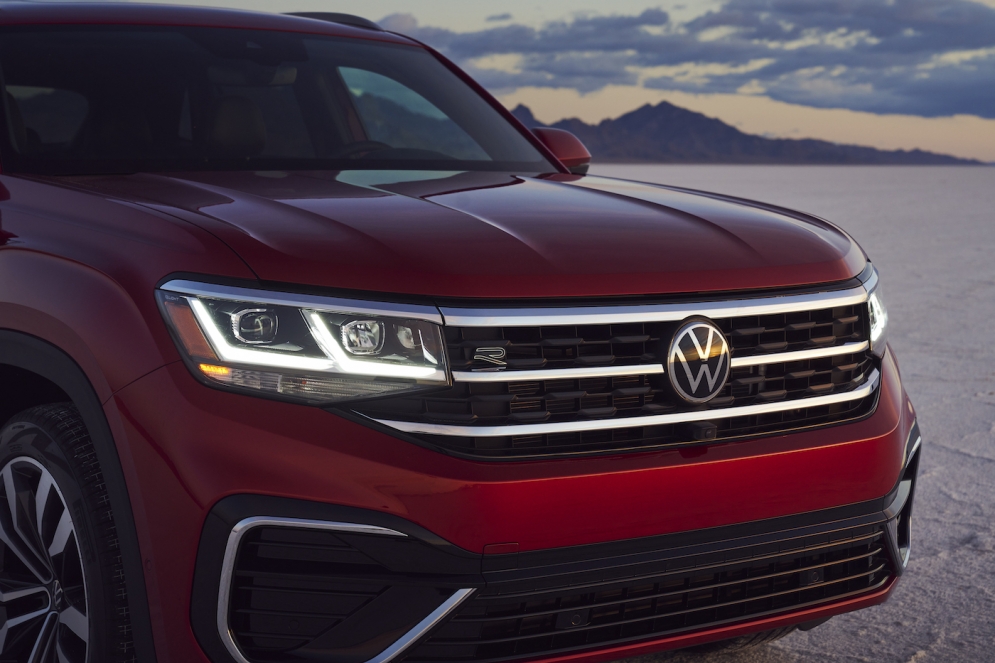LOOKS
The exterior of the Atlas Cross Sport that I tested featured an attractive Aurora Red Metallic paint job. The chrome front grille and front bumper design is quite eye-catching and stands out in the segment.
The vehicle features alloy wheels of either 18, 20 or 21 inches, depending on trim level. It also has LED headlights, an Adaptive Front Lighting System, power folding and heated side mirrors, rain-sensing, variable intermittent front wipers, a power tilting & sliding panoramic sunroof, and silver roof rails. All Atlas Cross Sport models feature 8 inches of ground clearance.
With a lower roofline than the three-row Atlas, and an angled rear hatch, the Atlas Cross Sport’s dimensions are 195.5 inches long, 78.4 inches wide, and 68.3 inches high. It is 5.2 inches shorter in length and 2.2 inches in height shorter than the Atlas.
Moving inside the Atlas Cross Sport, you’ll find lots of space for both cargo and for five passengers. Headroom measures at 39.4 inches and 37.8 inches in rows 1 and 2; with legroom at 41.6 and 40.4 inches. Rear bench seating offers a 60/40 split, with the ability to recline.
Atlas Cross Sport can boast of a max cargo volume of 77.8 cubic feet behind the front-row seats with rear seats folded down, and 40.3 cubic feet with rear seats up, and there’s lots of features to keep everyone happy (including USB and 12-Volt inputs, cup and bottle holders and storage space for small items).
Overall quality of the materials used in the Atlas Cross Sport was also quite strong, though not quite at the level of some of its competitors (Makes sense, as traditionally, VW has been functional, not flashy, with its interior designs). The leather seating was comfortable and nothing inside the vehicle felt cheap or low-quality. And controls are exactly where they need to be for ease of driver use.
Interior features include: Dual-zone automatic control w/ 2nd-row air vent, Heated, leatherette-wrapped steering wheel, heated and ventilated driver's seat and front passenger seat, heated rear seats, roll-up manual sunshades, and ambient lighting.
HOW’S THE RIDE?
The 2021 Atlas Cross Sport comes with a choice of two engines. My test vehicle featured the 2.0-liter four-cylinder turbo engine and its 235 horsepower and 258 pound-feet of torque. You can also upgrade to a 3.6-liter V6 that boosts the numbers to 276 HP and 266 pound-feet.
The Atlas Cross Sport features standard FWD or optional AWD (VW’s 4Motion AWD system), and a four-wheel independent suspension.
In my experience, the base engine was disappointing in overall performance, and somewhat slow to get up to speed. Zero-to-60 time is around 8 seconds. Eco, Normal, Sport and Custom drive settings are offered, but this is overall a less sporty vehicle than some rivals, and engine noise is also a bit louder.
Besides its power struggles, the rest of the driving experience in the Atlas Cross Sport is quite strong. It handles well for its size, responds immediately to driver input and also offers strong braking performance. Towing capacity is 5,000 pounds, and the AWD system is effective at eliminating loss of traction.
Beyond the traditional Onroad drive mode settings, AWD models also feature the option to select settings such as Snow and Offroad, which alter systems to best fit conditions by simply adjusting a knob.
TECHNOLOGY, SAFETY
Volkswagen has included its brand new infotainment system on most trim levels of the Atlas Cross Sport. Called the MIB3 system, it features an 8-inch display, multi-phone pairing, enhanced voice recognition, and multiple USB ports.
Touch controls on the infotainment system are generally straightforward, but take some time to master. Voice commands are very simple and effective (i.e.,"Tune to Yacht Rock Radio"). Navigation can be searched by address or by points of interest, and the system understands commands quite well.
The system features Navigation, AM/FM/HD Radio, and a three-month trial of SiriusXM satellite radio. There is also a quality-sounding Fender Premium Audio System including a subwoofer.
Other technology features in the vehicle include: Remote start, keyless access to all doors and liftgate, push-button start, anti-theft alarm system w/ engine immobilizer, Bluetooth for streaming music and calls and wireless charging for compatible devices.
Volkswagen also delivers a competitive amount of safety features for the segment.
Rearview camera is standard, as is Automatic Post-Collision Braking System and Blind Spot Monitor. The Atlas Cross Sport features six airbags, as well as Anti-lock Braking System and Electronic Stability Control. The Intelligent Crash Response System will also shut off the fuel pump, unlock the doors, and switch on the hazard lights if the car is involved in a collision.
Some higher trim levels of the Atlas Cross Sport feature IQ.DRIVE — which uses front and rear radar, a front camera and multiple sensors to collect data and enable features such as Forward Collision Warning and Autonomous Emergency Braking with Pedestrian Monitoring (Front Assist); Blind Spot Monitor (Side Assist); Rear Traffic Alert; Adaptive Cruise Control; Lane Keeping System (Lane Assist); Travel Assist; and Emergency Assist.
Travel Assist is a new feature on some trim levels, which allows for partially-automated hands-on driving in the Atlas Cross Sport, activated by a button on the steering wheel.
Among other safety features on the Atlas Cross Sport include Dynamic Road Sign Display; High Beam Control, Overhead View Camera, and Tire Pressure Monitoring System.
MPG
Official fuel mileage numbers on the Atlas Cross Sport with the four-cylinder engine and all-wheel drive are 20 city/24 highway/22 combined, and my experience confirmed those numbers are accurate. These are decent but not spectacular numbers in a segment featuring a wide range of two-row SUVs.
Other fuel economy numbers are 21/24/22 for the four-cylinder engine with FWD; 18/23/20 for the V6 with FWD; and 17/23/19 for the V6 with AWD. The Atlas Cross Sport features a 19.5-gallon fuel tank.
PRICE
The Atlas Cross Sport I tested was on the high end of the price range, and priced at just over $48,000. The base version starts around $33K, so there’s a wide price range depending on what features you include. These prices are generally in line with what you’ll pay for the many two-row SUV alternatives available, though it’s a bit higher than some competitors.
There are eight trim levels offered, and warranties on the Atlas Cross Sport include a new vehicle limited warranty for 4 years or 50,000 miles (whichever occurs first). Also VW’s Carefree Maintenance Program provides scheduled maintenance services for 2 years or 20,000 miles.
BOTTOM LINE
While not the most powerful option in the midsize, two-row SUV class, VW’s Atlas Cross Sport is a strong new-ish entry that is well-designed for cargo and comfort, and full of tech and safety innovations. For folks who like the Volkswagen aesthetic, but don’t need the three-row Atlas, this is a welcome alternative.
=====
AutoTechReviews.com can be found on Twitter @AutoTechReview, or stay updated at the AutoTechReviews Facebook page.
Matt Myfiu can be found on Twitter @MattMyftiu.




